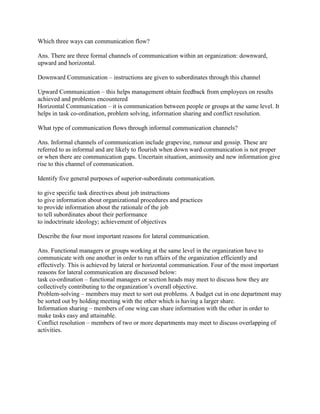Communication flow
•Transferir como DOCX, PDF•
0 gostou•6,103 visualizações
Denunciar
Compartilhar
Denunciar
Compartilhar

Recomendados
Recomendados
Mais conteúdo relacionado
Mais procurados
Mais procurados (20)
DIRECTIONS OF ORGANIZATIONAL COMMUNICATION - UPWARD AND DOWNWARD

DIRECTIONS OF ORGANIZATIONAL COMMUNICATION - UPWARD AND DOWNWARD
Semelhante a Communication flow
Semelhante a Communication flow (20)
$6.00 Discussion· Bythe due date assigned, respond to the assign

$6.00 Discussion· Bythe due date assigned, respond to the assign
$6.00 Discussion· Bythe due date assigned, respond to the assign

$6.00 Discussion· Bythe due date assigned, respond to the assign
$6.00 Discussion· Bythe due date assigned, respond to the assign

$6.00 Discussion· Bythe due date assigned, respond to the assign
formalandinformalcommunication-230917051433-039dafb4 (2).pdf

formalandinformalcommunication-230917051433-039dafb4 (2).pdf
formalandinformalcommunication-230917051433-039dafb4 (2).pptx

formalandinformalcommunication-230917051433-039dafb4 (2).pptx
Mais de Mazhar Iftikhar (mazhariftikhar@gmail.com)
Mais de Mazhar Iftikhar (mazhariftikhar@gmail.com) (20)
Communication flow
- 1. Which three ways can communication flow?<br />Ans. There are three formal channels of communication within an organization: downward, upward and horizontal. <br />Downward Communication – instructions are given to subordinates through this channel<br />Upward Communication – this helps management obtain feedback from employees on results achieved and problems encountered<br />Horizontal Communication – it is communication between people or groups at the same level. It helps in task co-ordination, problem solving, information sharing and conflict resolution.<br />What type of communication flows through informal communication channels?<br />Ans. Informal channels of communication include grapevine, rumour and gossip. These are referred to as informal and are likely to flourish when down ward communication is not proper or when there are communication gaps. Uncertain situation, animosity and new information give rise to this channel of communication. <br />Identify five general purposes of superior-subordinate communication.<br />to give specific task directives about job instructions<br />to give information about organizational procedures and practices<br />to provide information about the rationale of the job<br />to tell subordinates about their performance<br />to indoctrinate ideology; achievement of objectives<br />Describe the four most important reasons for lateral communication.<br />Ans. Functional managers or groups working at the same level in the organization have to communicate with one another in order to run affairs of the organization efficiently and effectively. This is achieved by lateral or horizontal communication. Four of the most important reasons for lateral communication are discussed below:<br />task co-ordination – functional managers or section heads may meet to discuss how they are collectively contributing to the organization’s overall objective.<br />Problem-solving – members may meet to sort out problems. A budget cut in one department may be sorted out by holding meeting with the other which is having a larger share.<br />Information sharing – members of one wing can share information with the other in order to make tasks easy and attainable.<br />Conflict resolution – members of two or more departments may meet to discuss overlapping of activities.<br />What are the consequences of a lack of upward communication?<br />Ans. Undoubtedly communication is the lifeblood of an organization. Without effective and efficient communication channels organizations can hardly survive. If information is not sent upward the organization may have to bear the brunt of it. Few of the consequences that may ensue lack of upward communication include:<br />Management remains unaware about activities of the workforce<br />Proper feed back is not given<br />Trouble areas are not brought into the notice of the management<br />Employees do not actively participate <br />There is an ever widening gap between the management and the workforce<br />Control is difficult as well as change<br />
